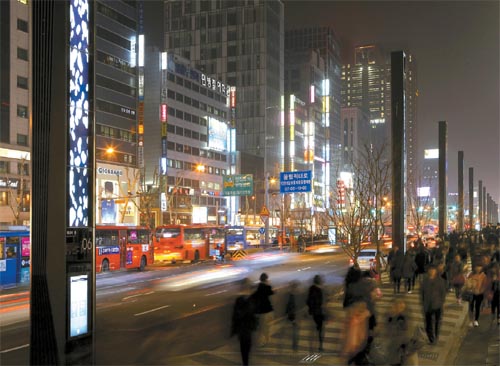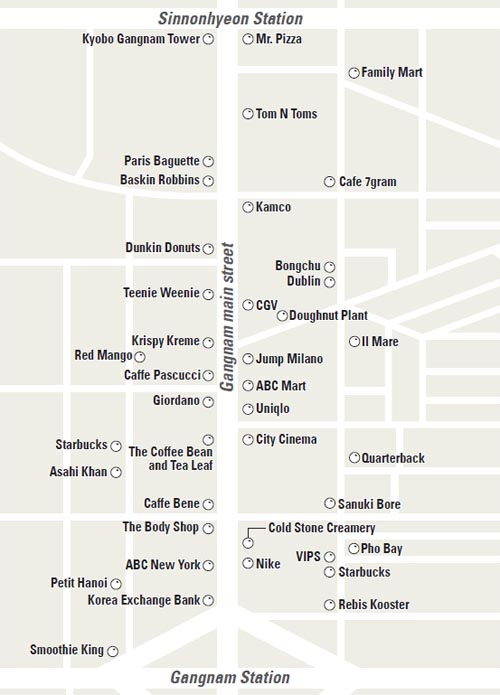Gangnam still popular despite high prices

“I bet there’s nowhere else in the country on a Monday afternoon that’s as busy as the Gangnam Station area is,” said Lee Young-seong, 42. “The increase in foot traffic around Gangnam Station is because many businesses have moved their offices here, including Samsung Town.”
Partly because of thriving high-end retail outlets, the area is a popular stomping ground for the country’s youth. A survey conducted by the JoongAng Ilbo and Hankook Research placed the area around Gangnam Station as the second most popular destination for those in their 20s and 30s, second only to the Hongik University area.
According to the survey of 1,047 respondents, the two areas were followed by Sinsa-dong (11 percent), Konkuk University (8 percent), Apgujeong-dong (5 percent) and Yeongdeungpo District (5 percent), among others.
A 760 meter-long-street that stretches from Gangnam Station, line No. 2, all the way to Sinnonhyeon Station, line No. 9, is considered the hub of Gangnam.

Gangnam’s main street is always bustling with life. [JoongAng Ilbo]
The area around Gangnam Station emerged as Korea’s representative business district after subway line No. 2 opened there in 1984.
“The area’s popularity is only natural, as it is convenient - in terms of both location and transportation,” said a real estate expert who requested anonymity.
Since the late 1990s, the headquarters of IT enterprises and conglomerates have gone up one after another near the station, transforming it into the business complex it is today and injecting the area with thousands of high-income consumers.
In 2002, Gangnam went through a boom and bust cycle, thanks mostly to the rise and fall of some venture businesses.
Partly as a result of that cycle, young people moved to nearby Apgujeong or Chungdam.
It was not until 2007 that the Gangnam Station area reversed its fortunes when Samsung Town was established. With an area of 39,000 square meters, 25,000 employees have made the daily commute to Samsung Town ever since. On top of that, another 1 million people are estimated to enter and exit the area per day. Teheran-ro, a sleepy district next to Gangnam Station, was revitalized after Samsung Town was built.
The Gangnam Station area can be divided in two sections; the east and the west. Bars and noribang (Korean karaoke rooms) are concentrated in the east, while the west is packed with restaurants and cafes.
Gangnam’s potential lies in its enormous floating population. According to the Gangnam District Office, an average of 210,000 people move through Gangnam Station on a daily basis. The station includes an underground commercial area with 210 stores.
“Twenty years ago when the first store opened here, there was no commercial advantage and we couldn’t dare think of attracting premium products,” said Yun Jong-hee, chief executive officer of Gangnam Station Shopping Center. “But unlike other underground shopping centers, Gangnam is the only one that is still crowded.”
During the weekends, 350,000 to 400,000 people visit the shopping center.
Despite the notoriously high rent, mainstream fashion brands are scrambling to open outlets on either side of Gangnam-ro. The street’s high foot traffic combined with pedestrians’ spending power is the biggest factor.
LG Fashion opened a store in November last year in the area. “Although the rent is quite a burden, the store in Gangnam plays an integral role in promoting the brand, and as the floating population is enormous, it is not so difficult to reach the break-even point,” said Kim In-gwon of LG Fashion.
The immediate area not only has two subway lines - Nos. 2 and 9 - but is also the start of most bus routes departing for destinations in Gyeonggi.
“Buses going past Gangnam Station add up to 40 routes, meaning the place is visited not only by Seoulites, but also by people from southern Gyeonggi,” said Ha Ji-seong, section chief of Hyundai Department Store. “If we could secure a location near Gangnam Station and open up a new store, it would no doubt become the best store with the highest profitability,” he added.
To take advantage of the high number of office workers around Gangnam Station, consumer outlets and banks have clamored for limited retail space.
One thing the area lacks is cultural spaces.
Office worker Jo Na-bin, 29, said that she and her friends have to hit the road if they want to do something cultural after work.
“As there are not enough cultural facilities around here, my colleagues and I have to go somewhere else to enjoy the evening after work,” said Jo. In fact, excluding CGV and City Cinema movie theaters, LIG Art Hall and the Gangnam branch of Kyobo Bookstore, there are few cultural spaces.
Because the area’s streets are so crowded, securing a place to hold outdoor concerts is nearly impossible, which is quite a contrast to the numerous street concerts to be found in Hongdae.
Moreover, small- and medium-sized businesses that normally inject diversity into an area are increasingly squeezed out because they are unable to cover the cost of ever-rising rents.
District officials, aware of the problem, have done their best to overcome the limitations. Gangnam District Office has set aside 8.5 billion won ($7.5 million) to create Gangnam U-Street. The project aims to create what officials say is the “Gangnam style.”
“I know there are criticisms that Gangnam is losing its uniqueness and popularity compared to Hongdae or Daehangno,” said Oh Jeong, head of Gangnam District Office’s urban design department. “We are going to adopt a new [approach] to create a unique style for the area that is similar to that of New York’s Times Square.”

By Lee Soo-ki [ebusiness@joongang.co.kr]










with the Korea JoongAng Daily
To write comments, please log in to one of the accounts.
Standards Board Policy (0/250자)